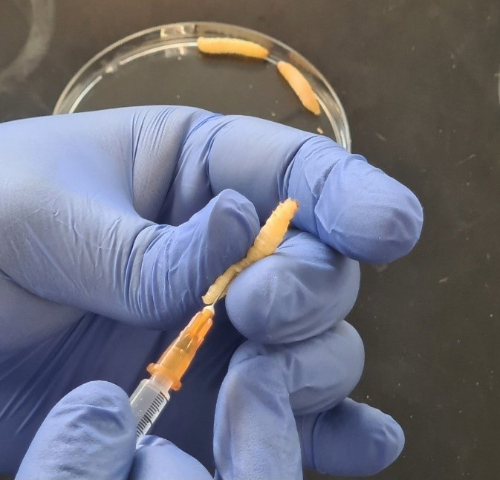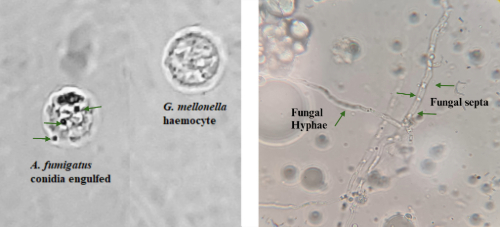Investigation fungal – host interactions using Galleria mellonella larvae
Posted on June 24, 2024 by Aaron Curtis
Aaron Curtis takes us behind the scenes of their latest publication 'Characterization of Aspergillus fumigatus secretome during sublethal infection of Galleria mellonella larvae' published in Journal of Medical Microbiology.
My name is Aaron Curtis and I am a PhD student in Maynooth University, Ireland. I work with Professor Kevin Kavanagh and together with the rest of the lab we study the molecular interactions between fungi and their host tissue in both agriculture and human health. To do this we utilise proteomic analysis which enables us to identify the proteins increased or decreased in abundance in response to environmental stresses and stimuli and as a result characterise the cell’s response. Protein expression requires a lot of energy from a cell and knowing the proteins a fungus prioritizes in response to their environment gives us a snapshot of what is important for their survival and development. This analysis can allow us to pinpoint important processes in a fungal pathogen during infection.
I study Aspergillus fumigatus, a fungus that has been identified as a critical priority pathogen by the WHO. This pathogen is normally found in the soil and on decaying vegetation but can cause a range of very serious, chronic and even lethal pulmonary infections in susceptible patients. Despite this, the transition from survival in the environment to persisting for years in the human lung remains poorly understood. In our work we aimed to uncover the processes that allow persistence to inform better detection and help identify novel drug targets to produce a targeted treatment for this infection.
We study the interaction of Aspergillus fumigatus with larvae of the insect mini-model Galleria mellonella, the greater wax moth. These insects are natural pests of honeybees and are found in the combs of beehives. Due to the high temperature in hives these insects can be kept at 37°C allowing for the study of human pathogens at relevant body temperature. We use Galleria as a model as they are an inexpensive, ethical and sustainable alternative to traditional murine models and provide comparable data. The main value of using Galleria is found in the similarity of their immune system to the innate immune response of mammals. For example, Galleria immune cells, haemocytes, act in a similar way to macrophages and neutrophils and are capable of phagocytosis, degranulation and net formation.

Image of Galleria mellonella larva inoculation procedure, the needle is inserted below the last left proleg.
Our recent work was a collaboration with colleagues in Masaryk University, Czechia, and supported through Erasmus+. We aimed to characterise how Aspergillus fumigatus developed during a sublethal infection, what it metabolised preferentially and what the fungus released into the host. This included the release of proteins, either through active secretion or as a by-product of degradation by the host. We also wanted to determine the impact these products had on the ability of the host to mount an immune response. We decided to study these factors during a sublethal infection as the majority of infections in humans are chronic, meaning there is a steady release of fungal products that could impact the health of the host.
We were able to track many of these factors in cell-free haemolymph (insect blood) including the protein and carbohydrate concentration which demonstrated a preference for simple carbohydrate utilisation in the initial 48 hours of infection. Protein metabolism is important as aromatic amino acid biosynthesis is suspected to be a key marker of pathogenic Aspergillus isolates and was observed in the later stage of infection. This could be important as many fungal metabolites such as fumiquinazoline and fumitremorgin require aromatic amino acids. These lesser studied toxins can enable further host decline resulting in fungal spread in the patient. We also monitored secretion of secondary metabolites gliotoxin and siderophores. These factors increased during infection and hyphal development was evident in vivo. We observed the behaviour of infected larvae change as their movement reduced following infection which was visualised using the FIMtrack system.

A. fumigatus infection in G. mellonella larvae during early-stage infection haemocytes can phagocytose fungal conidia (left panel) while in later stage hyphal growth occurs resulting in host tissue damage (right panel), magnification 100x.
Proteomic analysis was employed to characterise the proteins released by Aspergillus during infection and to visualise the Galleria response to infection. The results showed Aspergillus was releasing proteins associated with siderophore production as well as many enzymes and antigenic molecules that could damage the host and induce an immune response. On the host side we identified factors associated with the immune response being elevated and specifically proteins associated with the response to fungal pathogens, while insect immune nutrient reservoirs were depleted. We also identified an increase in the release of muscle proteins in the infected insects indicating tissue damage resulting from fungal infection. This would imply fungal persistence at a sublethal concentration can not only impact the immune response and morbidity of patients but also result in significant tissue damage.
It is likely that similar factors are being released in human lungs that are infected with Aspergillus fumigatus. The results provide an insight into how the pathogen and host interact and may provide evidence for earlier intervention of patients, potential targets for diagnostic tests or targets for therapeutic intervention potentially. We hope this work will form the foundation for future work and that we have identified targets of interest for people to examine in greater detail resulting in a more promising prognosis for patients who develop this disease.

